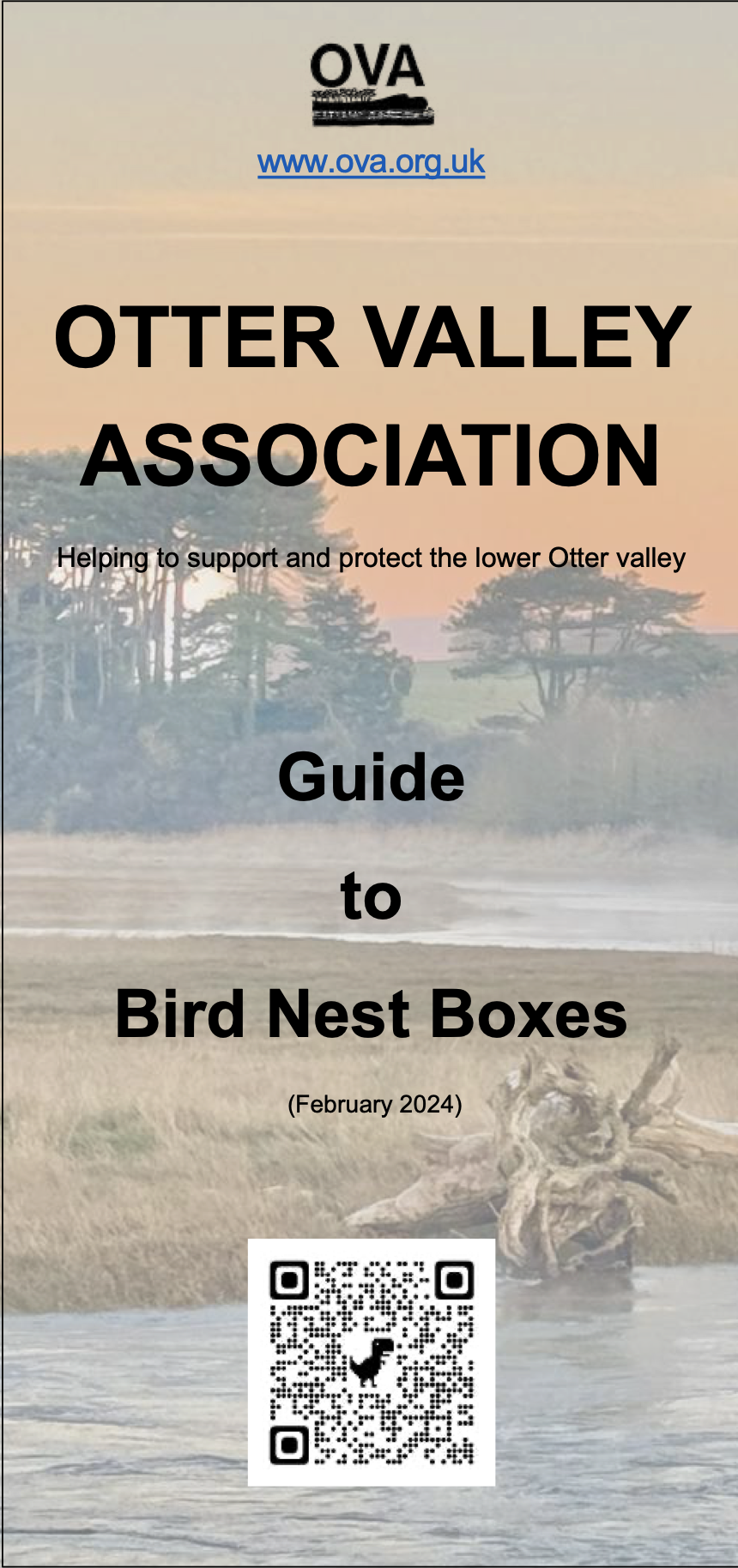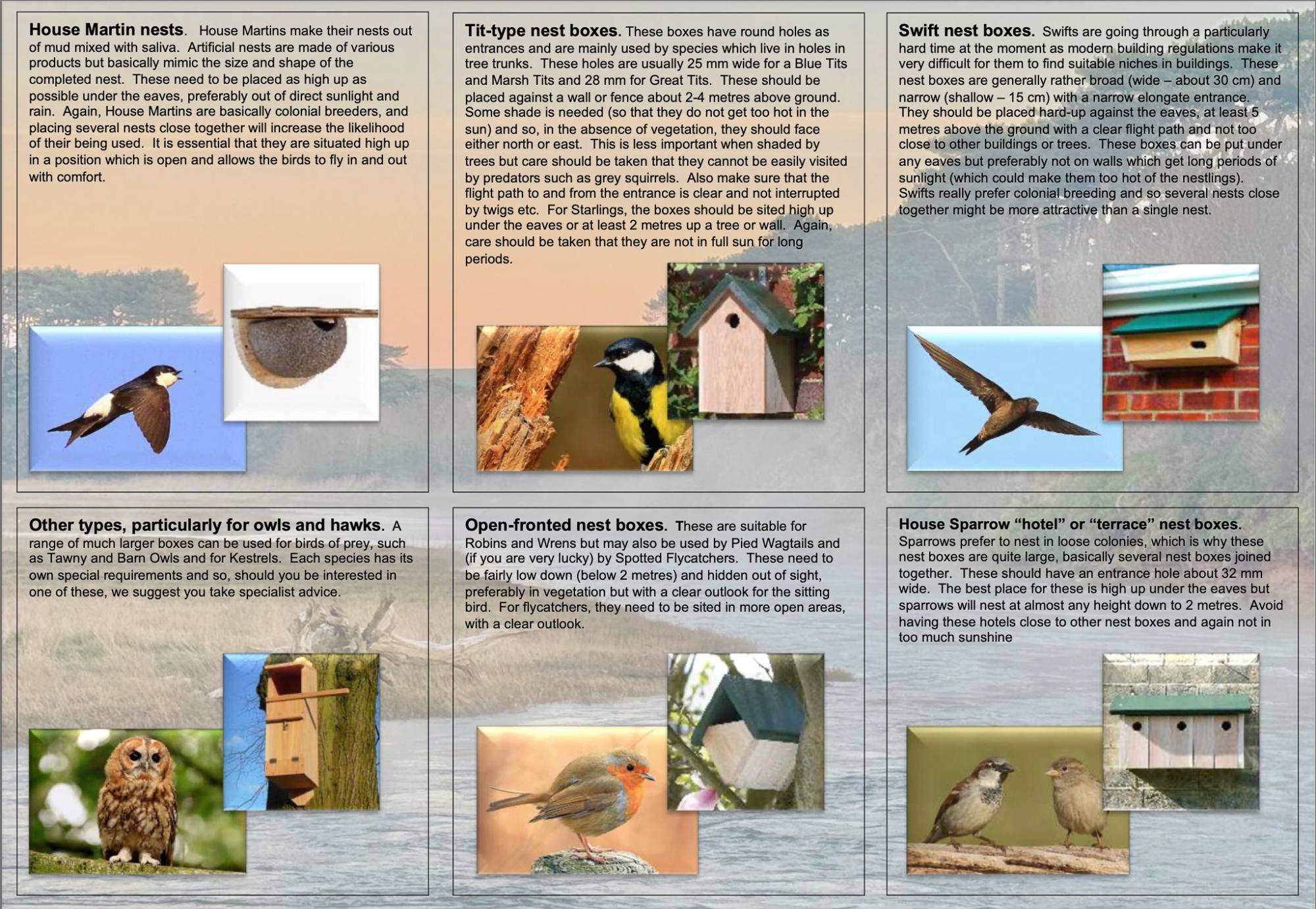Bird Nest Boxes are a wonderful way to help and observe birds within your garden or neighbourhood. There are many types that are outlined below. We hope you enjoy the material provided. If you would like to download and print a one-page leaflet about bird boxes, please do click here:
 |  |
Nest Box Construction
All types of nest boxes are available on the general market. If you are buying a nest box (rather than making your own) then you want to make sure that the wood is properly treated and that the boxes are well made. The nest boxes that the OVA has supplied to the local Primary Schools are made from FSC certified timber and have been treated with water-based preservatives so that no further treatment is needed. Indeed, we recommend that you let them weather so that they blend into the surroundings. They need to have such features as drainage holes to prevent waterlogging, in most cases perch-free entrance holes and deep chambers help to keep predators and intruders at bay. The best time for putting up nest boxes is in the winter or early spring. Nest boxes of this type are also available made of other materials and these are just as good as those made of wood. Nest boxes are not very hard to make and various plans for their construction can be found on the web. However, for your own lasting satisfaction, it is important that you use good, sound materials as suggested above.
Looking After Your Nest Box
Most nest boxes need some tender loving care. For tit, sparrow and starling nest boxes and the more open boxes used by robins etc, the actual material that the box is made of should not need maintenance. However, all nests harbour bird fleas and other parasites. These can survive over the winter (usually as eggs) and then hatch and infest the nestlings in the following Spring. It is important, therefore, to clear out nest boxes in the autumn and then treat them with boiling water which kills any parasites still present. Do not use pesticides. Having cleaned out the box, it would be helpful if a small handful of moss, clean hay or wood shavings were put back in the box. This is because nest boxes are often used to roost in on cold nights (a total of more than 60 wrens have been recorded roosting in a single nest box!) – and, in any case, the material may well be used to make the nest in the Spring. However, swift and house martin nests do not need cleaning.
Going Back to your Nest Box
It is important that, once a nest box is in use in the Spring, it should not be visited until the following Autumn. At that time, in addition to the old nesting material, it is possible that you will find unhatched eggs or even dead young birds. Sadly, at the present time, all bird species are stressed due to the environmental changes occurring on our planet, often mainly shortage of food. However, unusually cold weather or loss of one of the parents can also lead to a nest box becoming deserted and the loss of the brood. It is only in the Autumn, when clearing out a nest box, that these eggs and mummified bodies can be legally removed.
Predators
Predators that often try and enter nest boxes are cats, squirrels, rats, mice, stoats, weasels, woodpeckers and sometimes crows and magpies. For tit-boxes, metal rings are available to prevent some of these predators from breaking in and spoiling your fun!
Non-Use
It is not unusual for a nest box to remain unused, particularly in the first year. It is important to realise that local birds might already have suitable nest sites and will only use your boxes when the boxes are more suitable or when other sites are not available. So long as the birds can find suitable food nearby, patience should be rewarded! On the other hand, nest boxes can also be taken over by insects. Some of these may be less appropriate than others. Wasps, in particular, may go in and make their paper nests in nest boxes and these can be hard to get rid of.
House Martin Nests
House martins make their nests out of mud mixed with saliva. Artificial nests are made of various products but basically mimic the size and shape of the completed nest. These need to be placed as high up as possible under the eaves, preferably out of direct sunlight and rain. Again, House martins are basically colonial breeders, and placing several nests close together will increase the likelihood of their being used. It is essential that they are situated high up in a position which is open and allows the birds to fly in and out with comfort.
 |  |
Other Types, particularly for Owls and Hawks
A range of much larger boxes can be used for birds of prey, such as tawny and barn owls and for kestrels. Each species has its own special requirements and so, should you be interested in one of these, we suggest you take specialist advice.
 |  |
Tit-Type Nest Boxes
These boxes have round holes as entrances and are mainly used by species which live in holes in tree trunks. These holes are usually 25 mm wide for blue tits and marsh tits and 28 mm for great tits. These should be placed against a wall or fence about 2-4 metres above ground. Some shade is needed (so that they do not get too hot in the sun) and so, in the absence of vegetation, they should face either north or east. This is less important when shaded by trees but care should be taken that they cannot be easily visited by predators such as grey squirrels. Also make sure that the flight path to and from the entrance is clear and not interrupted by twigs etc. For starlings, the boxes should be sited high up under the eaves or at least 2 metres up a tree or wall. Again, care should be taken that they are not in full sun for long periods.
 |  |
Open-Fronted Nest boxes
These are suitable for robins and wrens but may also be used by pied wagtails and (if you are very lucky) by spotted flycatchers. These need to be fairly low down (below 2 metres) and hidden out of sight, preferably in vegetation but with a clear outlook for the sitting bird. For flycatchers, they need to be sited in more open areas, with a clear outlook.
 |  |
Swift Nest Boxes
Swifts are going through a particularly hard time at the moment as modern building regulations make it very difficult for them to find suitable niches in buildings. These nest boxes are generally rather broad (wide – about 30 cm) and narrow (shallow – 15 cm) with a narrow elongate entrance. They should be placed hard-up against the eaves, at least 5 metres above the ground with a clear flight path and not too close to other buildings or trees. These boxes can be put under any eaves but preferably not on walls which get long periods of sunlight (which could make them too hot of the nestlings). Swifts really prefer colonial breeding and so several nests close together might be more attractive than a single nest.
 |  |
House Sparrow 'Hotel' or 'Terrace' Nest Boxes
Sparrows prefer to nest in loose colonies, which is why these nest boxes are quite large, basically several nest boxes joined together. These should have an entrance hole about 32 mm wide. The best place for these is high up under the eaves but sparrows will nest at almost any height down to 2 metres. Avoid having these hotels close to other nest boxes and again not in too much sunshine.
 |  |
February 2024
Bird Photos - David R White
Bird Box Photos - RSPB
Download this web page as a leaflet
